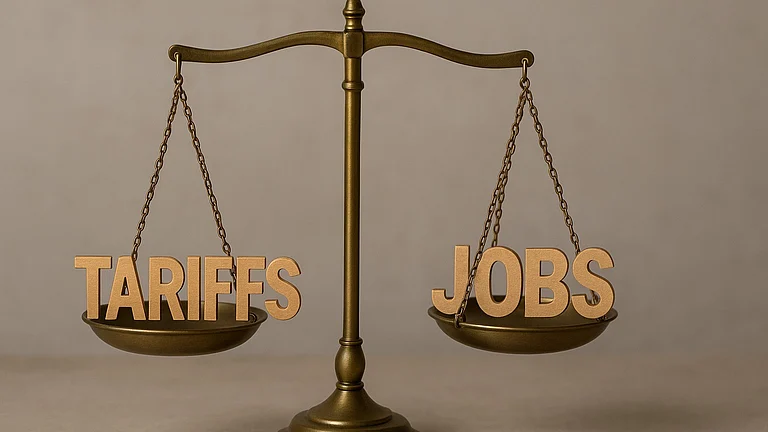*A 50% US tariff could cut exports by 60% and shave 1% off GDP; with weak consumption, tight fiscal space and sluggish investment, India has few buffers.
*The National Champion Policy and deal-driven environment deter private investment; reforms must dismantle excessive regulation, high trade barriers and distorted factor markets.
*Equal treatment for multinational corporations, tariff rationalisation and transparent procurement can attract investment, expand exports and anchor India in the new global order.
From Crisis to Reform: Turning a 50% Tariff Blow into Growth
The US tariffs risk derailing India’s growth, making structural reforms and global integration imperative
A 50% tariff on Indian exports to the US would deliver an immediate shock to India’s growth trajectory. Bloomberg Economics estimates a 60% reduction in outbound shipments to the US and a 1% fall in GDP.
To make up for the slowdown, Indian policymakers have four levers–consumption, government spending, private investment and newer markets. At a per capita income of $28,80 and with a slowing economy, domestic consumption cannot absorb a shock of this magnitude. With an estimated fiscal deficit of 4.4% and debt-to-GDP at 80%, there is little room to spend our way out of this slump. Boosting private investment, a metric that has been flagging in recent years, is the first step.
At 32%, the private sector’s contribution to gross fixed capital formation is the lowest since 2013. Clearly, the National Champion Policy is failing. Policies that offer preferential treatment to select domestic firms have been shown to fail across the world.
Economist and policy advisor Josh Felman’s discussion on Indonesia in Episode 321 of The Seen and the Unseen, a public policy and economics podcast, is a key exhibit. The problem worsens in a business environment tilted toward a few firms. Development economists Hallward-Driemeier and Pritchett call it a deals vs rules dichotomy. When selective enforcement and favouritism drive policies, the rest of the ecosystem faces heightened uncertainty, policy risk and fear of expropriation by the State. Under such conditions, private risk-taking drops.
A deal-driven business environment is a product of three drivers–excessive regulations, high barriers to trade and high taxation.
We rank 120th out of 121 countries in non-tariff measures (NTMs). This reflects our excessive regulations. Our firms pay uncompetitive factor costs to produce, which is a tacit tax by itself. Many of our tariff lines need to be brought down to 1–2% levels to match other Association of Southeast Asian Nations (Asean) countries. High tariffs are barriers to trade. We have to dismantle all three.
A public commitment to cut peak tariff rates by 99% over three years is the logical first step. That would also mean opening up our agricultural sector. Is the former possible? Our experience of rate rationalisation under Jaswant Singh offers comfort. Can India open agriculture? This sector is the last frontier yet to enjoy the benefits of liberalisation. It is time.
Non-tariff barriers are a tougher challenge. Delays of up to 15 days to clear consignments at ports mean half a month of tied-up capital in an economy that is always short on credit. Economists and trade analysts Sarmeen and Sundaram show that four Union government ministries are responsible for 87% of NTMs. A ground-up cost-benefit analysis of our compliances is needed.
Global Integration Key
Factor market dislocations represent the high taxation component of the trifecta. Energy costs are high, capital is constrained. Labour is unskilled and public order is absent. These raise the cost of doing business and alter the economics of risk-taking drastically. Addressing this will require the Union government to work closely with state governments to align reforms across energy, labour and public safety. That in turn demands novel quid pro quo mechanisms including reforms to Schedule VII of the Indian Constitution to open up policy space for states to act.
Tackling these three challenges remains the most feasible way to sustainably boost private capex. The same reforms that unlock private investment also form the precondition for securing better market access abroad.
A key part of our strategy to boost exports also has to recognise the role global MNCs will play in this new global order. Ajay Shah of XKDR Forum, a think tank and research collective, points out that the firms best poised to shift their markets swiftly are the foreign multinational corporations. The ability to easily set up shop, operationalise it and do their business is key. Indian policymakers must recognise this. The logical conclusion of this stance is to reform our investment treaty framework and commit to equal treatment for firms irrespective of origin.
Market access, including in government procurement, is essential to attract global firms to set up in India. Transparency and equal treatment in government procurement in emerging markets have long been a sticking point for Europeans, a subject that India has vehemently avoided in World Trade Organisation negotiations. Government procurement was one of the four elements of the “Singapore Issues”. India cited autonomy in procurement to defend its position. It is time to dismantle such insularity.
Seizing the Crisis
The Prime Minister of the United Kingdom during World War II, Winston Churchill once said, “Never waste a good crisis.” For us, this is one such crisis. A window to drive hard reforms has now opened. Unlike previous ones, we have a repository of knowledge to power us through. There is much reason to be optimistic. The opportunity is real.


